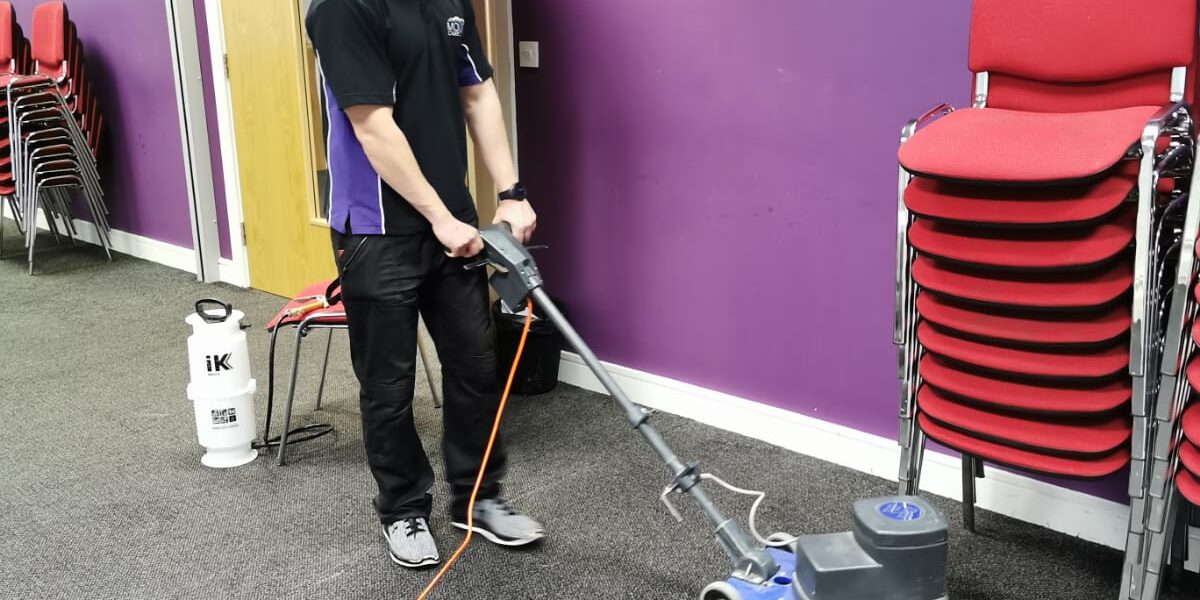Here are a few strategies you can use to avoid carpet stains and grime:
1. Use doormats: Doormats can help to prevent dirt, mud, and other debris from being tracked onto your carpets. Place mats at all entrances to your home to help keep your carpets clean.
2. Clean up spills immediately: To prevent spills from becoming stains, it’s essential to clean up spills on your carpets as soon as possible. Use a clean, dry cloth to blot the spill and apply a cleaning solution specifically designed for the type of stain you are dealing with.
3. Use furniture protectors: Furniture protectors, such as felt pads or coasters, can help to prevent furniture marks on your carpets. Place them under the legs of your furniture to protect your carpets from indentations.
4. Remove your shoes: Removing them before walking on your carpets can help reduce the amount of dirt and debris tracked onto them. Consider placing a shoe rack or mat by the door to encourage people to remove their shoes.
5. Vacuum regularly: Regular vacuuming is the key to cleaning your carpets. Aim to vacuum your carpets at least once a week, often in high-traffic areas.
6. Use protective coverings: To protect your carpets from spills or other messes, you can place protective coverings, such as plastic sheeting or drop cloths.
By following these strategies, you can help prevent stains and grime from accumulating on your carpets and keep them looking clean and fresh.
What are protective coatings for your carpets?
Protective coatings for carpets are products applied to the surface of carpets to protect them from stains, dirt, and wear. Professionals can use these coatings or purchase them in a spray form for DIY application. Protective coatings can help extend the life of your carpets by preventing damage from spills and foot traffic. Standard carpet protective coatings include Scotchgard, Stainmaster, and Teflon. These coatings form a barrier on the carpet’s surface that repels water and other liquids, making cleaning up spills and stains easier. They can also help prevent dirt and debris from penetrating the carpet’s fibres, reducing the need for frequent cleaning.
What is Scotchgard carpet coating?
Scotchgard is a brand of protective coating commonly used on carpets to protect them from stains and dirt. It is made of 3M and is applied to the carpet’s surface to create a barrier that repels water and other liquids. This can make cleaning up spills and stains easier and help prevent dirt and debris from penetrating the carpet’s fibres. Scotchgard is often used in high-traffic areas or homes with children or pets to help extend the carpet’s life. It is available in a spray form that homeowners or professionals can apply. It is typically used after the rug has been cleaned and is dry. Following the manufacturer’s instructions when applying Scotchgard to your carpet is essential to ensure it is used correctly and provides maximum protection.
What to look for when buying a vacuum cleaner for your carpets
There are several factors to consider when purchasing a vacuum for your carpets:
1. Type of vacuum: There are several vacuums to choose from, including upright, canister, stick, and handheld. Consider the type of carpet you have and the size of your home to determine the best vacuum for your needs.
2. Suction power: Look for a vacuum with strong suction power to remove dirt and debris from your carpet effectively.
3. Filtration system: Sound filtration is essential to trap allergens and prevent their release into the air.
4. Brush roll: A brush roll can help loosen and lift dirt and debris from the carpet, making it easier to vacuum.
5. Cord length: Consider the size of the cord to ensure that it is long enough to reach all areas of your home without needing to be constantly unplugged and re-plugged.
6. Weight and manoeuvrability: Look for a lightweight vacuum that is easy to manoeuvre to make cleaning easier.
7. Price: Determine your budget and look for a vacuum that offers the features you need at a price that fits your budget.
8. Customer reviews: Read customer reviews to get an idea of the pros and cons of different models and to help you make an informed decision.
Why make use of doormats for your carpets
Doormats are suitable for carpets because they help keep the dirt, dust, and debris tracked in from the outdoors from getting onto the carpet. This can help extend the carpet’s life and keep it looking clean and fresh. Doormats can be placed at the entrance of a home or in any high-traffic area to help catch dirt and moisture before they can get onto the carpet. They can also help reduce the amount of cleaning required, as they can help to prevent the build-up of dirt and grime on the carpet.
Questions to ask before hiring a professional carpet cleaning company
Here are some questions you should ask before hiring a professional carpet cleaning company:
1. Are you licenced and insured?
2. What types of cleaning products and methods do you use?
3. Do you offer any guarantees or warranties on your services?
4. Can you provide references or customer testimonials?
5. How much experience do you have in the carpet cleaning industry?
6. Do you offer any discounts or promotions?
7. Can you provide a detailed breakdown of the costs involved?
8. How long will it take for my carpets to dry after they have been cleaned?
9. Do you offer additional services like stain removal or deodorising?
10. Will you move my furniture for me, or do I need to do it myself?
How to hide carpet stains until a carpet cleaner arrives and more
Here are some tips for hiding carpet stains until a carpet cleaner arrives:
1. Use a white towel or cloth to blot the stain as much as possible. Avoid scrubbing the carpet, as this can cause the stain to spread.
2. If the stain is still visible, sprinkle a small amount of baking soda or cornstarch on it. These substances can help absorb excess moisture and make the stain less noticeable.
3. Place a piece of furniture, such as a chair or table, over the stain to help hide it.
4. Use a carpet stain cover spray to help mask the stain until it can be professionally cleaned.
In addition to hiding carpet stains, you can take some preventive measures to help prevent future stains. These include:
1. Vacuum your carpets regularly to remove dirt and debris that can lead to stains.
2. Use doormats at the entrances of your home to catch dirt and moisture before they can get onto the carpet.
3. Immediately clean up any spills or accidents to prevent them from becoming stains.
4. Consider using a carpet protector spray to help create a barrier between your carpet and potential stains.
The ten best carpet fabrics to consider
There are many factors to consider when choosing carpet fabric, including durability, stain resistance, and style. Here are ten carpet fabrics that are popular and may be worth considering:
1. Nylon: This synthetic fibre is strong, durable, and resistant to stains and fading. It is also easy to clean and maintain.
2. Polypropylene (olefin): This synthetic fibre is moisture-resistant and stain-resistant, making it a good choice for high-traffic areas or homes with children or pets.
3. Polyester: This synthetic fibre is soft and luxurious, resistant to fading and crushing, and easy to clean and maintain.
4. Wool: This natural fibre is durable, luxurious, and naturally stain-resistant. It is also hypoallergenic and environmentally friendly. However, it can be more expensive than synthetic fibres.
5. Acrylic: This synthetic fibre is soft and looks wool-like. It is resistant to stains and fading and easy to clean and maintain.
6. Silk: This natural fibre is luxurious and soft but not as durable as other fibres. It is also expensive and requires special care to maintain.
7. Sisal: This natural fibre is made from the leaves of the sisal plant. It is solid and durable but can be rough underfoot and not as soft as other fibres.
8. Jute: This natural fibre is soft, biodegradable, and environmentally friendly. However, it is not as durable as other fibres and is not resistant to moisture or stains.
9. Coir: This natural fibre is made from the husks of coconuts. It is solid and durable but can be rough underfoot and not as soft as other fibres.
10. Seagrass: This natural fibre is durable and environmentally friendly, but it is not as soft as other fibres and is not resistant to moisture or stains.
Ultimately, the best carpet fabric for you will depend on your specific needs and preferences. Consider factors such as the room’s traffic level, budget, and the level of care and maintenance you are willing to commit to.
What to consider when buying carpets for your home
There are a few things to consider when buying carpets for your home:
1. Quality: Look for carpets made of high-quality materials, such as wool or nylon, which are durable and resistant to stains.
2. Style: Choose a style that fits your taste and your home’s decor.
3. Colour: Consider the colour scheme of your room and choose a carpet colour that complements it.
4. Size: Measure the area where the carpet will be placed and buy the right rug.
5. Pad: Purchase a good-quality pad to go under the carpet to increase its lifespan and comfort.
6. Maintenance: Think about how easy the carpet will be to maintain and clean. Look for carpets that are stain-resistant and easy to vacuum.
7. Budget: Determine your budget and look for carpets that fit within it. Remember that investing in a high-quality rug may save you money in the long run due to its durability.
What to consider when buying carpets for your business premises
There are a few additional things to consider when buying carpets for your business premises:
1. Durability: Look for carpets that can withstand heavy foot traffic and resist stains and wear.
2. Safety: Consider the slip resistance of the carpet, especially in areas where spills or wetness may occur.
3. Maintenance: Choose a carpet that is easy to maintain and clean, as it will likely need to be cleaned more frequently than in a residential setting.
4. Cost: Determine your budget and look for carpets that fit within it, considering the long-term cost of maintenance and replacement.
5. Brand image: Consider the image you want to project to clients and employees and choose a carpet that aligns with that image.
6. Colour: Choose a professional and neutral colour, as it is more likely to match the decor and not go out of style.
7. Size: Measure the area where the carpet will be placed and buy the correct size.
8. Installation: Consider the cost and ease of installation and any necessary padding or underlayment.







